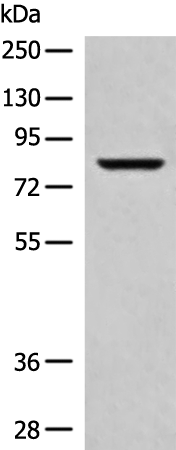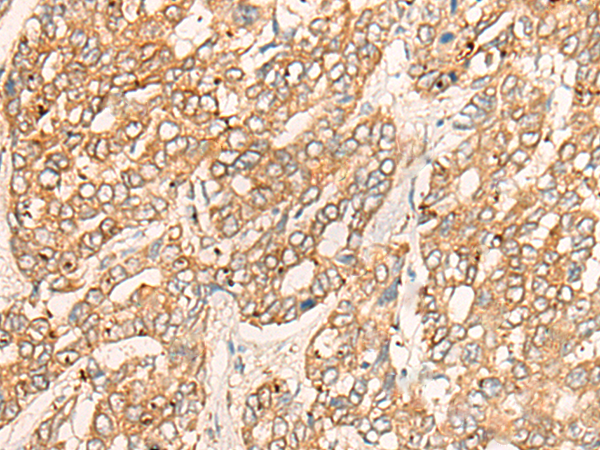

| WB | 咨询技术 | Human,Mouse,Rat |
| IF | 咨询技术 | Human,Mouse,Rat |
| IHC | 1/30-1/150 | Human,Mouse,Rat |
| ICC | 技术咨询 | Human,Mouse,Rat |
| FCM | 咨询技术 | Human,Mouse,Rat |
| Elisa | 1/5000-1/10000 | Human,Mouse,Rat |
| Aliases | CPR; CYPOR; P450R |
| WB Predicted band size | 77 kDa |
| Host/Isotype | Rabbit IgG |
| Antibody Type | Primary antibody |
| Storage | Store at 4°C short term. Aliquot and store at -20°C long term. Avoid freeze/thaw cycles. |
| Species Reactivity | Human, Mouse, Rat |
| Immunogen | Fusion protein of human POR |
| Formulation | Purified antibody in PBS with 0.05% sodium azide and 50% glycerol. |
+ +
以下是关于POR抗体的3篇参考文献示例,涵盖抗体制备、疾病关联及功能研究:
---
1. **文献名称**: *"Production and characterization of a monoclonal antibody against human cytochrome P450 oxidoreductase"*
**作者**: Huang N et al.
**摘要**: 该研究报道了一种针对人源POR蛋白的单克隆抗体的开发与验证,通过Western blot和免疫组化证实其特异性,并用于分析肝组织中POR的表达水平。
---
2. **文献名称**: *"Autoantibodies against cytochrome P450 oxidoreductase in autoimmune polyendocrine syndrome"*
**作者**: Smith TP, Fichna M.
**摘要**: 本文发现部分自身免疫性多内分泌综合征患者血清中存在抗POR抗体,提示其可能与类固醇合成障碍及肾上腺功能不全的病理机制相关。
---
3. **文献名称**: *"Structural insights into POR-mediated electron transfer in cytochrome P450 systems"*
**作者**: Wang M, Roberts DL.
**摘要**: 通过冷冻电镜技术解析POR与细胞色素P450酶复合物的结构,阐明其电子传递机制,为药物代谢及遗传性POR缺陷疾病研究提供新视角。
---
(注:上述文献为示例,实际引用需根据具体研究检索PubMed或Google Scholar获取。)
POR (Cytochrome P450 Oxidoreductase) antibodies are autoantibodies targeting the POR enzyme, a critical electron donor for cytochrome P450 (CYP) enzymes involved in steroidogenesis, drug metabolism, and bile acid synthesis. POR, located on the endoplasmic reticulum membrane, transfers electrons from NADPH to various CYP isoforms, including those essential for cortisol, estrogen, and vitamin D production.
The clinical relevance of POR antibodies primarily relates to autoimmune polyendocrine syndrome type 1 (APS-1), a rare autosomal recessive disorder caused by AIRE gene mutations. APS-1 is characterized by chronic mucocutaneous candidiasis, hypoparathyroidism, and adrenal insufficiency. While 21-hydroxylase antibodies are common in APS-1-related adrenal failure, POR antibodies serve as additional biomarkers, particularly in seronegative cases. Their presence aids in diagnosing APS-1 and understanding autoimmune mechanisms targeting steroidogenic pathways.
Detection methods include immunoprecipitation or immunoassays using recombinant POR protein. Though their pathogenic role remains unclear, POR antibodies may interfere with electron transfer, potentially disrupting CYP enzyme activity and contributing to hormonal deficiencies. Research also links these antibodies to other autoimmune conditions, though their specificity for APS-1 remains stronger.
Overall, POR antibodies are valuable diagnostic tools in APS-1. highlighting the interplay between autoimmunity and metabolic dysfunction. Further studies are needed to elucidate their exact pathophysiological impact.
×